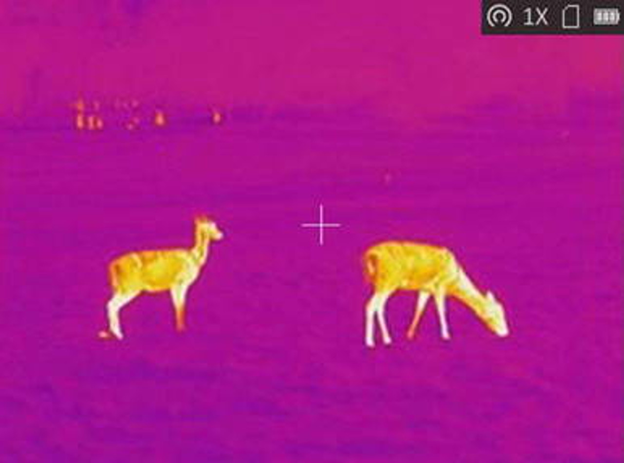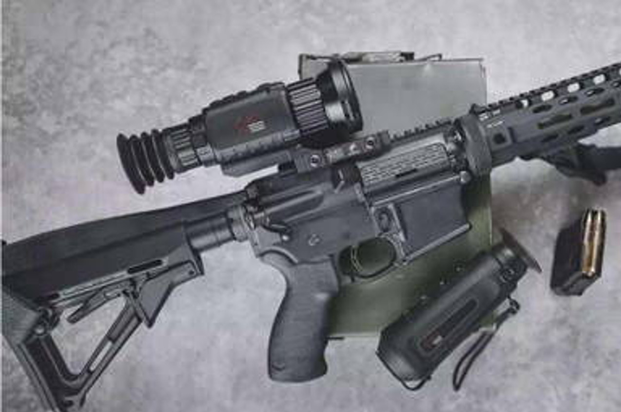In the market for a new thermal optic? Whether you’re here for a thermal rifle scope, a clip-on, a monocular or binoculars, here are some of the questions you may want to address before you purchase.
1. What are the real-world applications of thermal rifle scopes?
Thermal rifle scopes (and other optics) have multiple real-world applications. Law enforcement officials may use them for surveillance, as can security crews. They can also be used for search and rescue operations.
For most civilians, however, the main applications of thermal scopes are for predator control or feral hog hunting, as they allow for precise and confident target detection and identification of warm-blooded targets, even in complete darkness. Some even have ballistic calculators, and in the case of thermal rifle scopes, can be used to take accurate, effective, ethical shots.
2. What’s the difference between a thermal scope and a monocular?
Fundamentally, not much. The only main difference between a thermal monocular and rifle scope is that the scope will have mounts for a firearm, and will have a reticle to be used for zeroing the rifle. Effectively, the difference between a thermal scope and monocular, all else being equal, are the same as those between a “regular” glass-optic scope and monocular.
3. What is sensor resolution?
Sensor resolution (for instance, 640x480) is the number of pixels the sensor captures. A higher resolution results in a sharper display image, all else being equal. However, it is important to recognize that sensor resolution is not the only factor that influences the overall clarity of the display image.
4. What is NETD rating?

NETD rating, or “noise equivalent temperature difference” rating, is another critical factor that determines how sharp the image display will be. In laymen’s terms, NETD rating is how sensitive a sensor is to differences in temperature. The greater the sensitivity, the better the sensor can capture and display small thermal differentials. A lower NETD rating is preferred, and will result in a sharper image, even in adverse conditions, such as hot and muggy weather.
5. What is frame rate?
Frame rate, measured in Hertz (Hz), is a metric that indicates how often the screen’s display refreshes. A faster frame rate results in a smoother viewing experience and less lag, which is critical when tracking moving targets, or when you yourself are moving.
6. What is pixel pitch?
Pixel pitch is the distance between the center of two adjacent pixels on a thermal sensor. The smaller the pixel pitch, the faster and sharper the display will be. Currently, the majority of thermal optics have either 12μm or 17μm pixel pitches; now, with the release of the InfiRay HCH50R, we have the industry’s first 10μm thermal optic, which is extremely fast and sensitive.
7. What are AMOLED and OLED displays?
OLED stands for “organic light-emitting diode” and is the more cost-effective of the two options; it also offers good contrast, but runs the risk of “burning” an image onto the screen. By contrast, AMOLED displays, or “active matrix organic light-emitting diode” displays, while more expensive, offer higher refresh rates and power savings due to energy efficiency. Think of AMOLED like a slight upgrade over OLED.
8. Are there any advantages to a thermal rifle scope that offers more than one color palette?
Yes, there are potentially several. One is that some color palettes are more energy efficient than others, resulting in longer battery life. Another is that some color palettes, such as crimson color palettes, are better for night vision as they don’t cause the dreaded “night blindness” of other color palettes.
9. What is the difference between night vision and thermal?

Night vision is closer to conventional optical imaging; it makes use of ambient light and amplifies it so that it can be more clearly seen by the human eye.
Thermal imaging, on the other hand, works in complete darkness by detecting radiation that is not on the visible spectrum, and from it constructs thermal imaging. Naturally this gives thermal imaging several significant advantages over thermal imaging.
10. Why is thermal imaging better than night vision for night hunting?
There are numerous reasons why thermal imaging can be more valuable to nocturnal hunters than conventional night vision optics, despite the fact that night vision is more affordable.
One is that thermal optics work in total darkness. Even in the complete absence of ambient light, thermal optics still work.
The other is that heat can penetrate fog, precipitation, and in some cases, vegetation, making it better in adverse conditions. Moreover, the detection range of thermal optics is comparatively better than most night vision optics.
Contact Us If You Still Have Questions
Hopefully you found this guide helpful, but if after reading you still have questions about thermal rifle scopes, get in touch with Dark Night Outdoors at 309-781-8421 and let us know how we can help.


